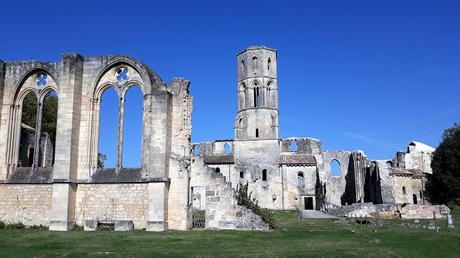
A few weeks ago I at long last got to visit one of the Bordeaux area’s most renowned UNESCO World Heritage sites: the ruins of Grande-Sauve Abbey, or Abbaye de la Sauve-Majeure, in the village of La Sauve, 30 kilometres to the east of the city in the Entre-Deux-Mers winegrowing region. Having regularly seen the romanesque abbey from afar I was already aware of its impressive scale, but I was looking forward to getting an inside view of this former Benedictine monastery.
The abbey’s history can be traced back to the 11th century, when it was founded by Abbot Gérard de Corbie on woodland that was conveniently located mid-way between the Dordogne and Garonne rivers (or between two "seas"... entre deux mers!) and that had been gifted to him by the Duke of Aquitaine. The abbey developed and flourished, went on to become home for up to 300 monks at any given time, and established itself as a stop for pilgrims making their way along the Camino de Santiago route to and from northern Spain.
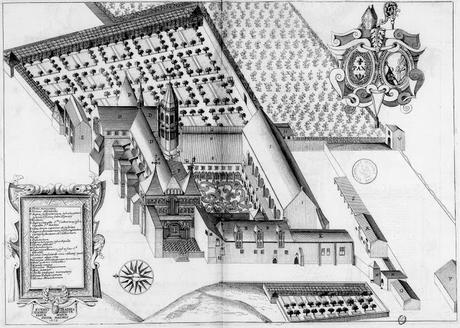
The abbey as it was in the 17th century, as depicted in the Monasticon Gallicanum and stored by the Bibliothèque nationale de France (picture source: Wikipedia).
It was not all plain sailing though: the abbey suffered substantial damage during the Hundred Years’ War (1337-1453), a powerful storm in 1665 heavily affected the roofs of the church, dormitories and refectory, and the structure was further weakened by an earthquake in 1759. The final blow was the French Revolution in 1789, at which stage the abbey’s assets were confiscated and dispersed for good.Surviving buildings were used as a prison but, after the church roof collapsed in 1809, the site became a quarry for local villagers who used the stone to build their homes! Later in the 19th century a Jesuit college was set up, and was then converted into a teacher training college, until the site was once again vacated subsequent to a fire in 1910. Finally, during the First World War, the buildings that were still standing housed a small military hospital.

Inside the church.
Fast-forward to 1960 when the French State acquired the property and consolidated what remained of the abbey ahead of its opening to the general public as part of France’s Centre des monuments nationaux network of heritage sites, a turn of events that culminated in its 1998 listing as a UNESCO World Heritage site.The modern-day visit takes in the very visible remains of the abbey church, and the more minimalist vestiges of various monastic buildings. The latter include the chapter house where monks met for discussions and decision-making, the cloister which would have been a garden and place of prayer and meditation, the scriptorium where monks copied out texts (their dormitory would have been on the upper floor), and the refectory.

Top: what remains of the cloister, scriptorium and refectory (i.e. not much) and, bottom, what remains of the chapter house (i.e. not much, either).
Among the most striking things about the church itself are the relatively well-preserved consecration medallions portraying the apostles, and the series of extremely ornate carved capitals at the top of various columns that depict different Biblical scenes ranging from the original sin and Daniel in the lion’s den, to the life of Samson and the temptation of Christ. There are others which draw on mythological creatures and tales, such as (possibly) Homer’s Ulysses resisting the bewitching song of the sirens. It would take far too long to list them all here, but happily the French-language Wikipedia page about the abbey does a fine job at doing just that! There are also a host of niches, vaults, windows and doorways that must all have a thousand stories to tell.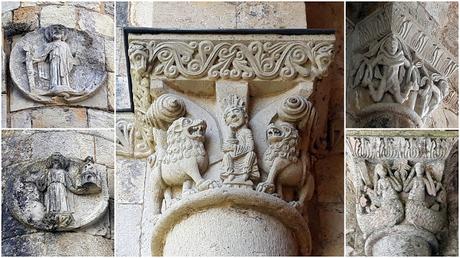
Some of the many carved medallions and chapters. On the left: apostles Saints Jude and Matthew; centre: Daniel and his large feline acquaintances; and on the right, what may or may not be Ulysses, slightly tied up and therefore fully equipped to resist the sirens' call!
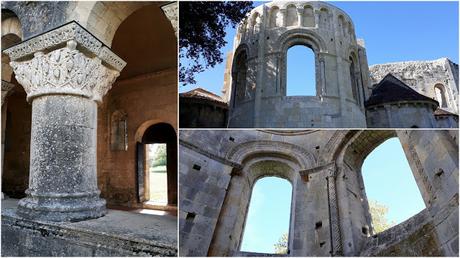
In amongst the abbey's nooks and crannies.
The octagonal and no doubt restored bell tower was another unexpected delight. A winding staircase comprising 157 steps enables the abbey’s more courageous visitors to climb all the way to the top and enjoy a magnificent view over the village of La Sauve and the rolling plains of the Entre-Deux-Mers… not to mention over the roofless church itself. It all makes for an unusual juxtaposition of past and present.
The bell tower, the staircase and the view over the village.

Looking down on the church, its nave and chevet, including the chancel and adjoining chapels.
The sense of traveling through time extends to the neighbouring grounds, where a medieval herb and vegetable garden has been recreated, giving a sense of the quietly productive atmosphere that must have reigned at the time when the monastery was in full operation.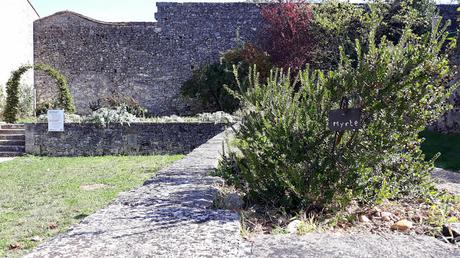
Finally, the village of La Sauve itself is far more than just a backdrop to the imposing abbey. Some of the more unusual finds to be enjoyed include Saint-Pierre de La Sauve parish church (complete with some particularly exotic gargoyles), an old wash-house, and a 19th-century building which was reportedly one of France’s smallest prisons, if not the smallest, with its two tiny cells. Urban legends suggest it only ever got used once, or perhaps even never at all (La Sauve is clearly very low on crime).

La Sauve's tiny jail.
And, of course, the village’s presently-disused railway station can be viewed alongside what is now the Roger-Lapébie cycle path connecting Latresne with Sauveterre-de-Guyenne, providing an ideal, direct carbon-neutral route to La Sauve and its historic treasures!> Find it on the Invisible Bordeaux map: Abbaye de la Sauve-Majeure, La Sauve
> Official website: www.abbaye-la-sauve-majeure.fr
> Full opening hours and practical information here.> I also heavily recommend the self-guided walking tour of the area that you'll find by clicking here.
